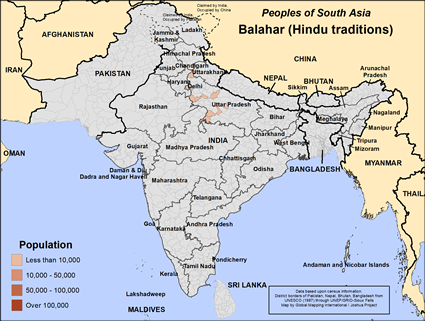The Balahar people are also known as the Vargis, Chobdars or Thakurs. They came from Rajasthan where they once had a close economic and social links with the powerful Rajputs and other ruling communities. They worked as town criers who announced news from the Rajas to the villages. Since that time, the Balahar have migrated east to north central India.
The primary language of the Balahar is Hindi. Many resources are available in Hindi including a complete Bible, the JESUS Film and radio programs. There are few if any Balahar believers in Christ. They live in Uttar Pradesh, a state where Hindi is the primary language.
Most Balahar people are farmers or herd livestock for a living. Most farm on land owned by others. As sharecroppers they must give a large percentage of their produce to the landowners. Other Balahar care for sheep, goats and cattle. They sell meat, dairy products and animal hides to buy things they cannot make for themselves such as cell phones and appliances. The Balahar are classified as an OBC or other backward castes by the Indian government. That means they are able to obtain government jobs and special university admissions. Balahar are considered to be outside the Hindu religious system. They are often victims of discrimination in Indian society.
Some Balahar have received an education work for the government. Child labor is common among them. Many Balahar are unable to read and write. Children often quit school after a few years to help their families make a living.
Like almost all Hindus, the Balahar people do not eat beef, though they are not vegetarians.
Their marriages are arranged by family negotiations. They marry within their group but not within their particular clan. Divorce can be initiated by either party on the grounds of adultery or incompatibility. The aggrieved party is compensated with money. All the sons of a couple get an equal inheritance. Balahar tend to have large families. In rural areas they frequently do not have access to modern medicine or clean water. Life expectancy is low and child mortality is high.
The Balahar people practice Hinduism, the ancient religion of India. Since they are from a low class community, they have their own priests and shrines. Hinduism is a catch-all phrase for the local religions of South Asia, so it is very diverse. At the popular level, Hindus worship and serve the gods of the Hindu pantheon. They visit Hindu temples and offer prayers, food, flowers, and incense to their gods in hopes of gaining protection and benefits. They do not have a personal or familial relationship with their gods like Christians or Jews. There are other Hindus who are much more philosophical, especially among the Brahmins.
Almost all Hindus participate in yearly celebrations like Holi, the festival of colors and the start of spring / Diwali, the festival of lights / Navratri, the celebration of autumn / and Rama Navami, Rama's birthday.
The Balahar have great needs. They need good schools for their children. They need access to modern medicine. They need literacy and new job skills. Like all other unreached peoples of the world, this people group needs the blessings and guidance that only Jesus Christ can offer.
Pray that Balahar would be able to provide for their children with excellent schools.
Pray that these Hindus will be given the chance to taste and see that the Lord is good.
Ask the Lord to send out loving workers to go to the Balahar people.
Pray for the Balahar to tune into Hindi radio programs.
Pray that more Balahar would read the Hindi Bible and embrace the message.
Ask the Lord to raise up a growing church among the Balahar in this decade.
Scripture Prayers for the Balahar (Hindu traditions) in India.
https://www.wikiwand.com/en/Balahar
peoplegroups.org/explore/GroupDetails.aspx?peid=49359
| Profile Source: Joshua Project |











